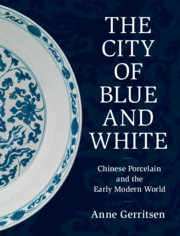Book contents
- The City of Blue and White
- The City of Blue and White
- Copyright page
- Dedication
- Contents
- Figures
- Maps
- Table
- Acknowledgements
- 1 The Shard Market of Jingdezhen
- 2 City of Imperial Choice: Jingdezhen, 1000–1200
- 3 Circulations of White
- 4 From Cizhou to Jizhou: The Long History of the Emergence of Blue and White Porcelain
- 5 From Jizhou to Jingdezhen in the Fourteenth Century: The Emergence of Blue and White and the Circulations of People and Things
- 6 Blue and White Porcelain and the Fifteenth-Century World
- 7 The City of Blue and White: Visualizing Space in Ming Jingdezhen, 1500–1600
- 8 Anxieties over Resources in Sixteenth-Century Jingdezhen
- 9 Skilled Hands: Managing Human Resources and Skill in the Sixteenth-Century Imperial Kilns
- 10 Material Circulations in the Sixteenth Century
- 11 Local and Global in Jingdezhen’s Long Seventeenth Century
- 12 Epilogue: Fragments of a Global Past
- Notes
- Bibliography
- Index
9 - Skilled Hands: Managing Human Resources and Skill in the Sixteenth-Century Imperial Kilns
Published online by Cambridge University Press: 24 February 2020
- The City of Blue and White
- The City of Blue and White
- Copyright page
- Dedication
- Contents
- Figures
- Maps
- Table
- Acknowledgements
- 1 The Shard Market of Jingdezhen
- 2 City of Imperial Choice: Jingdezhen, 1000–1200
- 3 Circulations of White
- 4 From Cizhou to Jizhou: The Long History of the Emergence of Blue and White Porcelain
- 5 From Jizhou to Jingdezhen in the Fourteenth Century: The Emergence of Blue and White and the Circulations of People and Things
- 6 Blue and White Porcelain and the Fifteenth-Century World
- 7 The City of Blue and White: Visualizing Space in Ming Jingdezhen, 1500–1600
- 8 Anxieties over Resources in Sixteenth-Century Jingdezhen
- 9 Skilled Hands: Managing Human Resources and Skill in the Sixteenth-Century Imperial Kilns
- 10 Material Circulations in the Sixteenth Century
- 11 Local and Global in Jingdezhen’s Long Seventeenth Century
- 12 Epilogue: Fragments of a Global Past
- Notes
- Bibliography
- Index
Summary
This chapter focuses on skill, and considers how the sixteenth-century imperial kiln administrators managed their workforce. Skilled craftsmen were in high demand, but they were difficult to control. Most of the workers were mobile; they could take their labour to the imperial kiln, but also find work in the private kilns. The repeated attempts of the kiln administrators to identify skilled workers and bind them to the imperial kilns, and their ongoing expressions of concern over the issue of skilled labour underscore how difficult it was to get hold of good craftsmen. Circulation and mobility characterized the workers' presence in Jingdezhen. The more goods and people circulated and flowed between the various spaces, the more the adminstrators sought to assert their control over it those flows, and the wider the discrepancies between the written representations of the idealized circumstances the administrators envisioned and the actual patterns of movement and flow of resources and skills. Ultimately, the kiln administrators had to reconcile themselves to their inability in asserting control over the labour force. Material and human resources were fluid and flowed relatively freely through the mazelike veins of the Jingdezhen network.
Keywords
- Type
- Chapter
- Information
- The City of Blue and WhiteChinese Porcelain and the Early Modern World, pp. 175 - 194Publisher: Cambridge University PressPrint publication year: 2020



